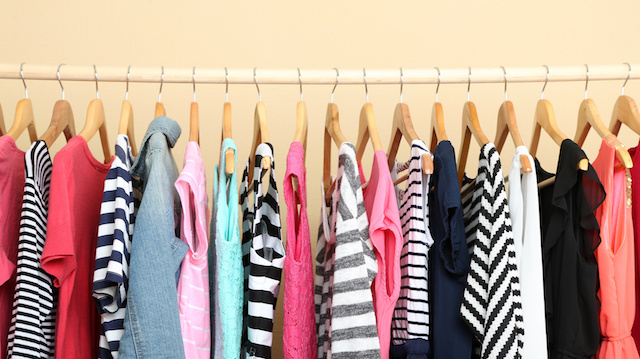
Picture this: You’re out shopping and happily pick out some fresh new threads. You come home and put on a mini fashion show in front of the mirror with all of your cool outfits. A few minutes later, your eyes start to sting, and you feel a strange itching around your neck. To your horror, there are hives popping up all over your skin. Alarmed, you realize it might be the new clothes and quickly take them off.
What’s going on here? Recently, it has come to light that clothing manufacturers are treating garments with an array of toxic chemicals. These are used to keep items looking fresh and wrinkle-free, as well as to prevent mildew while items are in shipment for weeks or months on end.
Unfortunately, consumers have rarely heard of these dangers and purchase wrinkle-free or permanent-press clothing without knowing. Formaldehyde, the chemical most commonly associated with the preservation of corpses, is what is usually employed to give fabrics this convenient but deadly treatment.
While acute reactions like the one described above are not very common, they do happen, and other chronic health issues can also occur from exposure to these chemicals. People with amplified chemical sensitivity or those who have been subject to a heavy toxin load (through their work environment, or by purchasing a new home or car, for example) may suffer from headaches, aches and pains, fatigue, nausea, asthma and breathing difficulties.
Even people who don’t have a particular sensitivity can experience rashes or dermatitis, which is an inflammation of the skin, especially at sites where clothing is tight.
Formaldehyde is a highly toxic chemical that is classified as a carcinogen by the International Agency for Research on Cancer, but largely goes unchecked. In New Zealand, for example, tests have found that some clothing produced in China emit levels of formaldehyde up to 900 times over the limit considered safe for human use. Similar clothing is sold every day in other countries with less stringent regulations.
Clothing is not the only source of this toxin. Many other products, such as mattresses, bed linens, pillows, carpeting, curtains, furniture, cars and other upholstered items, have been treated in a similar fashion. It has even been found in baby shampoo and imported fish products.
Tests done by the U.S. Government Accountability Office in 2010 found that the worst offenders were crib sheets, easy-care pillow cases and baseball hats. These items exceeded the maximum level allowed for products that touch the skin, which is 75 parts per million (ppm), based on the Consumer Product Safety Improvement Act of 2008.
The levels must be lower than 20 ppm for products geared toward children younger than three years, but conversely are allowed to be as high as 300 ppm for products such as outerwear, which don’t touch the skin directly.
An interesting side note — Victoria’s Secret was once vilified in a lawsuit where their coveted bras were found to have high levels of formaldehyde.
Another class of chemicals that sparks similar concerns is called nonylphenol ethoxylates, or NPEs. These chemicals are commonly used as detergents in the textile industry. A Greenpeace report from 2011 found traces of these bioaccumulating carcinogens on products from a number of large, popular clothing manufacturers.
Below are other substances to be aware of:
- Brominated flame retardants — widely used on children’s sleepwear.
- Perfluorinated chemicals — used to make breathable synthetic fabrics.
- P-Phenylenediamine (PPD) — used as a coloring agent on black clothing and leather, as well as in hair dyes.
- Phthalates — used to make plastics softer, such as in new shoes or synthetic clothing and jackets.
 In fact, at least 8,000 different chemicals are used in the manufacture of modern clothing.
In fact, at least 8,000 different chemicals are used in the manufacture of modern clothing.
All of the above are classified as potential agents of cancer and may cause skin problems or even infertility.
If you’re looking to move away from these toxic risks, here are some ways to improve your shopping savvy:
- Stick with lighter-colored clothing in natural fabrics, such as cotton or bamboo.
- Avoid wrinkle-free or permanent-press clothing (try using steam to eliminate wrinkles instead) — also beware of clothing that is flame-retardant, water-repellant, anti-static or antibacterial.
- Buy second-hand clothing — it’s better for the environment, and your wallet, too!
- Buy locally made and/or organic clothing items — most of these carcinogenic chemicals are banned or highly regulated in Western countries. The European Union has stringent requirements, so if you can find clothes actually made in Europe (not just imported there), you should be safe.
- Avoid direct skin contact with synthetic or treated fabrics, particular in hot or humid weather, when your pores open and admit more toxins.
- If you have sensitive skin, avoid the chemical-laden fabrics discussed above, and also consider using a gentler, more natural soap, or not using any at all.
Protect yourself and your family from insidious toxin exposure and make the move toward purchasing healthier, greener clothing.
Also, try these super detox smoothies to shed any junk accumulated in your body.
—The Alternative Daily
Sources:
http://onlinelibrary.wiley.com/doi/10.1111/j.1398-9995.1964.tb03256.x/abstract
http://www.sciencedirect.com/science/article/pii/019096229270295Q
http://jama.jamanetwork.com/article.aspx?articleid=656950
http://archderm.jamanetwork.com/article.aspx?articleid=534148
http://journals.lww.com/dermatitis/Abstract/2004/12000/Diagnosis_and_Treatment_of_Dermatitis_Due_to.2.aspx
http://www.nicnas.gov.au/communications/publications/information-sheets/existing-chemical-info-sheets/formaldehyde-in-clothing-and-textiles-factsheet
http://www.medicaldaily.com/pulse/wash-and-wear-new-clothes-possess-toxic-chemicals-may-lead-severe-allergic-reactions-334254
http://www.dailymail.co.uk/femail/article-2088623/Toxic-dyes-Lethal-logos-Cotton-drenched-formaldehyde–How-clothes-poison-you.html
http://www.totalhealthmagazine.com/Allergies-Asthma/Consumers-Beware-Toxins-Lurking-in-Your-Clothing.html
http://naturalsociety.com/chemical-clothing-toxic-chemicals-clothes-sick
http://www.nytimes.com/2010/12/11/your-money/11wrinkle.html?_r=0
http://www.davidsuzuki.org/blogs/queen-of-green/2014/04/how-to-reduce-your-formaldehyde-exposure
http://www.gao.gov/new.items/d10875.pdf

